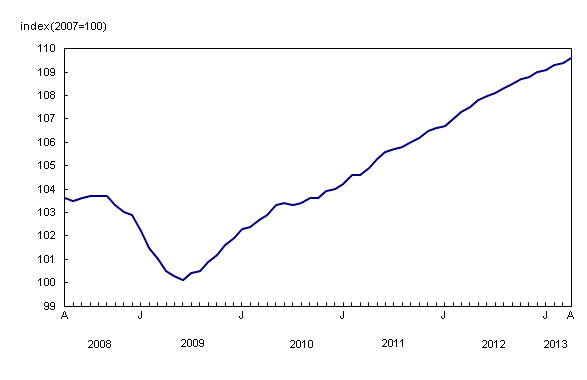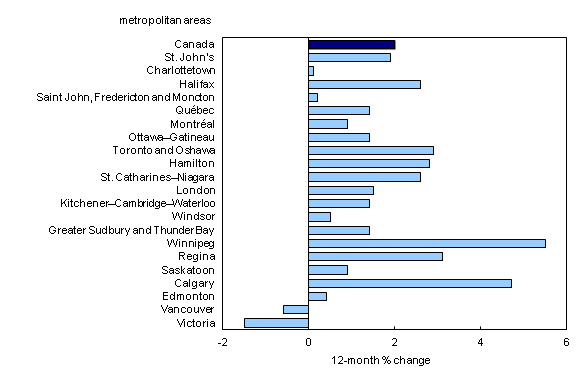New Housing Price Index, April 2013
Archived Content
Information identified as archived is provided for reference, research or recordkeeping purposes. It is not subject to the Government of Canada Web Standards and has not been altered or updated since it was archived. Please "contact us" to request a format other than those available.
Released: 2013-06-13
The New Housing Price Index (NHPI) rose 0.2% in April, following a 0.1% increase in March and similar gains over the past 12 months.
For the third consecutive month, Calgary was the top contributor to the national advance, as prices for new homes rose 0.5% in April. Builders reported that higher material and labour costs as well as market conditions were the main reasons for higher prices.
The largest monthly price advance occurred in St. John's (+1.0%), following eight consecutive months of little or no price change. Builders reported higher material and labour costs as the reason for the rise in that region. This was the largest price movement in St. John's since November 2010, when new housing prices rose 4.3%. Since then, prices have been relatively flat, despite a few modest gains over the summer of 2012.
Hamilton followed closely with prices for new homes rising by 0.8% in April. Builders cited market conditions as the reason for the advance, the largest in that region since October 2012.
New housing prices were also up in Winnipeg (+0.6%) and Saskatoon (+0.3%). This was the second monthly increase in a row for Saskatoon, following 10 months of little or no price movement.
In April, prices decreased 0.1% in the combined metropolitan region of Saint John, Fredericton and Moncton, as well as in Montréal.
Builders in the region of Saint John, Fredericton and Moncton reported lower prices as a result of market conditions, while builders in Montréal lowered prices to finalize sales.
Prices were unchanged in 5 of the 21 metropolitan regions surveyed.
On a year-over-year basis, the NHPI rose 2.0% in the 12 months to April, following a similar increase the previous month.
The main contributor to the advance was the combined region of Toronto and Oshawa, where the year-over-year increase in contractors' selling prices was 2.9%. Annual price increases in this region have been slowing since the start of 2013, following steady growth throughout 2011 and the early part of 2012.
For the fifth consecutive month, Winnipeg recorded the largest year-over-year price movement in Canada. Prices were up 5.5% in April following a 5.1% advance in March.
Other significant year-over-year increases occurred in Calgary (+4.7%), Regina (+3.1%) and Hamilton (+2.8%). In Calgary, annual price gains have been generally accelerating throughout 2012 and 2013.
Among the 21 metropolitan regions surveyed, only Victoria (-1.5%) and Vancouver (-0.6%) posted 12-month price declines in April, continuing a long stretch of annual decreases in the two western-most regions.
Note to readers
The New Housing Price Index measures changes over time in the selling prices of new residential houses agreed upon between the contractor and the buyer at the time of the signing of the contract. It is designed to measure the changes in the selling prices of new houses where detailed specifications pertaining to each house remain the same between two consecutive periods. The prices collected from builders and included in the index are market selling prices less value added taxes, such as the Federal Goods and Services Tax (GST) or the Harmonized Sales Tax (HST).
Effective April 1, 2013, builders in British Columbia once again paid a 7% Provincial Sales Tax (PST) on their building materials. The PST on building materials in British Columbia is now embedded in the contractors' selling prices of new houses, representing an average of about 2% of the home's final price.
Effective April 1, 2013, in Prince Edward Island, the federal 5% GST was combined with a reduced 9% provincial tax to create a single 14% HST. Previously, only the GST (5%) was applied to new homes. Under the new rules, the tax applied to the purchase of a new home is 14%.
The indexes are not subject to revision and are not seasonally adjusted.
The first quarter 2013 issue of Capital Expenditure Price Statistics (Catalogue number62-007-X) will be available in July.
The New Housing Price Index for May will be released on July 11.
Contact information
For more information, or to enquire about the concepts, methods or data quality of this release, contact us (toll-free 1-800-263-1136; infostats@statcan.gc.ca) or Media Relations (613-951-4636; statcan.mediahotline-ligneinfomedias.statcan@canada.ca).
- Date modified:



